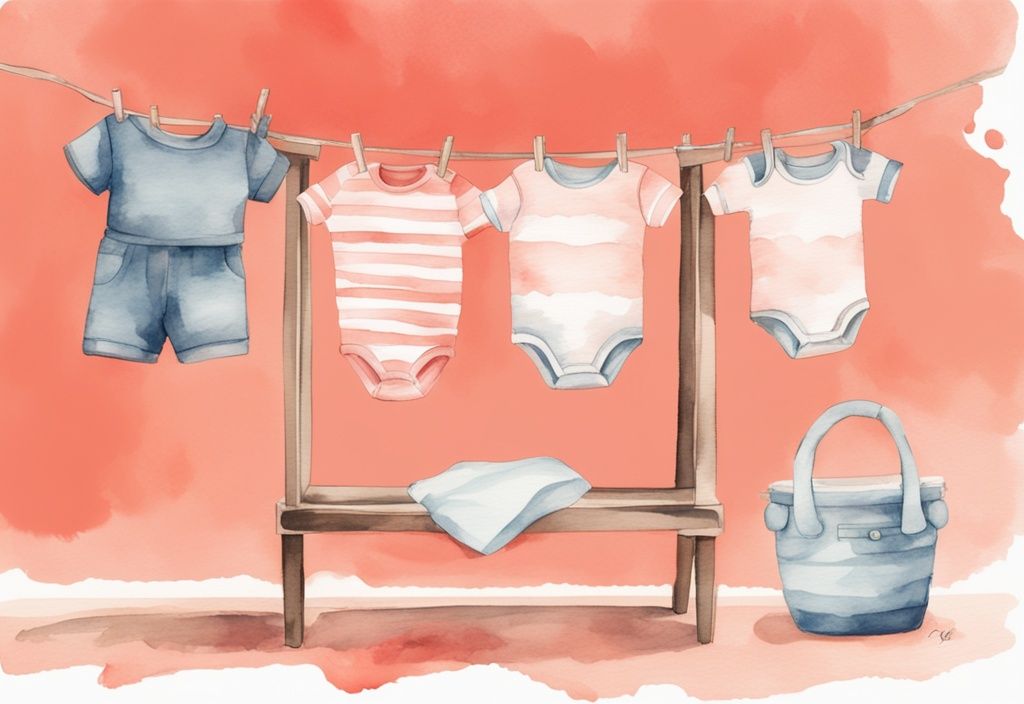Do you ever wonder how to keep your little one’s clothes soft and long-lasting? Drying them properly is the key! Doing so safeguards against nasty shrinking disasters and pesky skin irritations. As a mom, I’ve learnt the importance of proper drying techniques and am excited to share my insights with you on how to dry baby clothes safely and efficiently.
Whether you’re a fan of the tumble dryer or inclined towards air drying, I’ve got you covered! This article is packed full of practical tips and easy-to-follow steps ensuring your baby’s garments remain comfy and durable through as many change cycles as you need.
So, let’s get those little clothes fluttering gently in the breeze (or tumbling!) without compromising their quality or your baby’s comfort. After all, happy baby equals happy mommy, right?
Steps to Take Before Drying Baby Clothes
When it comes to drying baby clothes, a little preparation goes a long way. By following these simple yet essential steps, you’ll ensure your baby’s clothes stay in top-notch condition, safe and comfy for their delicate skin.
Separating Baby Clothes from Adult Laundry
- It’s crucial to wash baby clothes separately from adult laundry to prevent cross-contamination with detergents and residues that might irritate a baby’s sensitive skin. Using dedicated laundry loads means you can ensure that any harsh chemicals present in adult detergents do not transfer to baby clothes, providing a safer wash for your little one’s garments.
- Baby clothes are often lighter and more delicate compared to adult fabrics, requiring special care during both washing and drying. By separating them, you can cater to their unique needs, selecting gentler cycles and lower temperatures that won’t damage their delicate fabrics.
Decoding and Following Care Labels
- Each item of baby clothing comes with care labels that contain essential information for maintaining their quality. These labels provide specific instructions on washing and drying, which, when followed, help prevent damage and extend the life of the clothes. Neglecting these guidelines can result in shrinking, fabric weakening, or color fading.
- Pay attention to symbols and instructions regarding water temperature, drying methods, and the use of certain detergents. For instance, some baby clothes may recommend air drying to avoid the risks associated with high-heat tumble drying. A careful review of these labels ensures that each garment is treated appropriately.
Choosing the Right Detergent and Wash Cycle
- Selecting the right detergent is paramount in preventing skin irritation and ensuring the longevity of baby clothes; you can find valuable tips on choosing the best laundry detergents for your little one at https://www.dreft.com/en-us/washing-tips/detergent-tips/laundry-detergents-facts-and-tips. Hypoallergenic detergents are formulated specifically to be gentle on delicate skin and reduce the risk of allergic reactions. Avoid detergents with strong fragrances or harsh chemicals that might remain in the fabric fibers after washing.
- When it comes to washing, opting for a gentle cycle and using cold water are key practices. Gentle cycles minimize agitation, reducing the wear and tear on delicate fabrics. Cold water helps preserve the fabric’s integrity and prevents colors from bleeding or fading, keeping clothes looking fresh for longer.

How to Safely and Efficiently Dry Baby Clothes
The Pros and Cons of Using a Tumble Dryer
Using a tumble dryer to dry baby clothes can feel like a lifesaver, especially when you’re juggling the wonderful chaos of parenthood.
On the upside, tumble dryers are a go-to during gloomy weather, offering fast and reliable drying. They’re great for clothes that don’t shrink easily when set on low heat. However, the downside is real too. Tumble dryers can be harsh on delicate fabric, hastening wear and tear with their high heat and tumbling action. There’s also the potential risk of shrinkage and loss of elasticity if you crank up the temperature too much.
How to Set the Dryer for Baby Clothes
Let’s talk settings! When drying your baby’s clothes in a tumble dryer, the gentle or low heat setting is your best friend. This helps protect those precious delicate fabrics. Make sure to take the clothes out promptly once they are dry or even just a bit damp. This little step helps avoid overheating and shrinkage, keeping your baby’s clothes in great shape.
The Benefit of Wool Dryer Balls
Ever heard of wool dryer balls? They’re game-changers! Using these in your dryer can boost drying efficiency like magic. These natural, chemical-free helpers improve air circulation, slashing drying time. Plus, they soften baby clothes and zap static without dousing your laundry in harmful chemicals.
Why to Avoid Fabric Softeners and Dryer Sheets
Fabric softeners and dryer sheets might seem like they’d add that extra softness, but they can actually be a bit of a menace. These products can mess with the flame-retardant qualities of certain fabrics. Plus, they often leave residues that can irritate your baby’s sensitive skin. Best to skip these and keep things safe and comfy for your little one.
Methods for Air Drying Baby Clothes
Line Drying: Step-by-Step and Tips
Line drying is a wonderful, eco-friendly option to dry baby clothes. Start with a clean clothesline and hang the clothes, making sure they’re spaced out nicely for optimal airflow. For colored garments, turn them inside out to prevent sun-fading. This method is fantastic for keeping baby clothes looking fresh and lasting longer.
Drying Racks: The Forgotten Solution
Don’t underestimate the humble drying rack! It’s a practical and often overlooked method. Lay the clothes flat on the rack to maintain their shape and avoid stretching. If you’re curious about the quirky sleeping positions of little ones, you might wonder, why does my baby sleep with his butt in the air. Place the rack in a well-ventilated spot to speed up drying. This gentle method is perfect for delicate fabrics and makes the most of limited space.
Using Sunlight for Natural and Safe Drying
Sunlight is a mom’s best ally when it comes to drying baby clothes. It not only disinfects but also naturally bleaches out stains. Whites get brighter, and bacteria get zapped. Just remember, while sun is great, don’t overdo it with colored clothes to prevent fading. This eco-friendly approach harnesses nature for the win!

Air Drying Inside During the Cold Months
Winter can be tricky for air-drying, but it’s doable with the right strategy. Place the drying rack in a well-ventilated area, preferably with an electric fan to boost airflow. Positioning the rack where the air circulates well will speed up drying and prevent mildew, keeping those baby clothes fresh and clean.
How to Prevent Common Drying Issues
When drying baby clothes, it’s essential to keep in mind a few important tips to ensure they stay in good condition and safe for your little one’s sensitive skin. Below are some common drying challenges and how to overcome them.
Keeping Baby Clothes from Shrinking
Understanding how to dry baby clothes properly can help you avoid the hassle of shrinkage. One golden rule is to dry on low heat settings. High heat can cause fibers to contract, making those adorable outfits too small too soon. For an even safer option, consider air drying. It’s as simple as placing the slightly damp clothes flat on a drying rack or hanging them on a clothesline to finish drying naturally. To further safeguard against shrinkage, remove the clothes from the dryer while they are still slightly damp. This step ensures they don’t get over-dried and keeps them in perfect shape.
Eliminating Irritation Risks on Baby’s Skin
Your baby’s comfort is paramount, which means we need to be extra careful with the products we use. Opt for mild, hypoallergenic detergents specifically designed for baby clothes. These special detergents are gentle on your little one’s delicate skin. Also, steer clear of fabric softeners and dryer sheets—they might leave residues that could irritate. To make sure that every bit of detergent is rinsed out, consider running an extra rinse cycle. This little step can make a big difference in keeping your baby’s clothes soft and irritation-free. For optimal comfort, it is important to maintain the right environment in your baby’s room, such as knowing what should the humidity be in a baby room.
Protecting Baby Clothes from Mildew and Mold
Ensuring baby clothes are completely dry before storing them is another crucial step in learning how to dry baby clothes effectively. Any lingering moisture can invite mold and mildew, which you definitely want to avoid. For air-drying methods, remember to rotate the clothes frequently on drying racks or lines. This ensures even drying, reducing the risk of damp spots where mold can thrive. Proper ventilation in your drying area also plays a significant role in keeping mold and mildew at bay. Your baby’s clothes will be fresh, clean, and safe to wear every time.
Additional Tips: Efficiency in the Drying Process
Mastering the art of drying baby clothes can make a huge difference in your daily routine. Let’s dive into some practical tips that can help you tackle this task with ease and efficiency.
Using a Dehumidifier to Speed Up Drying
When it comes to discovering how to dry baby clothes efficiently, using a dehumidifier can be a game changer. Place a dehumidifier in the room where your baby clothes are air-drying, and you’ll notice a significant reduction in the room’s moisture levels. This not only speeds up the drying process but also minimizes the risk of mildew and mold growth. Your baby’s clothes will stay fresh and safe to wear, giving you one less thing to worry about.
Properly Folding and Hanging Clothes Post-Drying
Post-drying care is crucial for maintaining the quality of baby clothes. To avoid wrinkles and creases, fold or hang the clothes immediately after they’ve dried. I’ll tell you a little secret: using soft hangers prevents stretching and preserves those delicate fabrics. This attention to detail makes a world of difference, keeping your baby’s garments pristine and comfortable.

Maintaining a Clean Lint Filter
A clean lint filter is vital for the efficient drying of baby clothes. Regularly cleaning the lint filter in your tumble dryer enhances drying performance and keeps your machine operating safely. Removing lint build-up prevents potential fire hazards and promotes optimal airflow, which, in turn, speeds up the drying process.
How to Store Baby Clothes After Drying
Proper storage of baby clothes post-drying is essential for maintaining their cleanliness and extending their lifespan. Always store the clothes in a cool, dry place to avoid mildew. Keeping them in drawers or closets will protect them from dust and mites. This approach not only keeps the garments looking new but also ensures they are always ready for use.
Frequently Asked Questions
Is High Heat Safe for Baby Clothes?
High heat isn’t the best friend of baby clothes. It can cause shrinkage and damage those delicate fabrics. Instead, stick to low heat or, even better, air drying. This way, you’ll keep your little one’s clothes in tip-top shape.
Can I Use Fabric Softeners on Baby Clothes?
Avoid fabric softeners, as they can leave residues that might irritate your baby’s sensitive skin and harm flame retardant properties. Opt for baby-friendly, hypoallergenic detergents to ensure comfort and safety for your precious one.
How Can I Keep Baby Clothes from Shrinking?
Always follow the care instructions on the garment labels. Use low heat settings in your dryer, and whenever possible, choose air drying. Steer clear of high heat to prevent any irreversible damage to the cutest outfits.
What’s the Best Practice for Indoor Clothes Drying?
Good air circulation is key! Use fans or dehumidifiers, drying racks, and ensure clothes are spread out evenly. This helps avoid mildew and retains the shape and quality of baby clothes, keeping them fresh and clean.
Keeping Baby Clothes Soft: Air Drying Tips
Want those clothes to stay soft? Add a bit of white vinegar or baking soda to the wash. When air drying, lay the clothes flat or hang them properly. This prevents stiffness and keeps the fabrics cuddly soft, just the way we want for our little ones.


